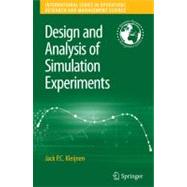
Note: Supplemental materials are not guaranteed with Rental or Used book purchases.
Purchase Benefits
What is included with this book?
| Introduction | p. 1 |
| What is simulation? | p. 1 |
| What is DASE? | p. 7 |
| DASE symbols and terms | p. 10 |
| Solutions for exercises | p. 12 |
| Low-order polynomial regression metamodels and their designs: basics | p. 15 |
| Introduction | p. 16 |
| Linear regression analysis: basics | p. 19 |
| Linear regression analysis: first-order polynomials | p. 27 |
| First-order polynomial with a single factor | p. 27 |
| First-order polynomial with several factors | p. 28 |
| Designs for first-order polynomials: resolution-III | p. 36 |
| 2[superscript k-p] designs of resolution-III | p. 36 |
| Plackett-Burman designs of resolution-III | p. 39 |
| Regression analysis: factor interactions | p. 40 |
| Designs allowing two-factor interactions: resolution-IV | p. 42 |
| Designs for two-factor interactions: resolution-V | p. 46 |
| Regression analysis: second-order polynomials | p. 49 |
| Designs for second-degree polynomials: Central Composite Designs (CCDs) | p. 50 |
| Optimal designs and other designs | p. 51 |
| Validation of metamodels | p. 54 |
| Coefficients of determination and correlation coefficients | p. 54 |
| Cross-validation | p. 57 |
| More simulation applications | p. 63 |
| Conclusions | p. 66 |
| Appendix: coding of nominal factors | p. 66 |
| Solutions for exercises | p. 69 |
| Classic assumptions revisited | p. 73 |
| Introduction | p. 73 |
| Multivariate simulation output | p. 74 |
| Designs for multivariate simulation output | p. 77 |
| Nonnormal simulation output | p. 78 |
| Realistic normality assumption? | p. 78 |
| Testing the normality assumption | p. 79 |
| Transformations of simulation I/O data, jackknifing, and bootstrapping | p. 80 |
| Heterogeneous simulation output variances | p. 87 |
| Realistic constant variance assumption? | p. 87 |
| Testing for constant variances | p. 88 |
| Variance stabilizing transformations | p. 89 |
| LS estimators in case of heterogeneous variances | p. 89 |
| Designs in case of heterogeneous variances | p. 92 |
| Common random numbers (CRN) | p. 93 |
| Realistic CRN assumption? | p. 94 |
| Alternative analysis methods | p. 94 |
| Designs in case of CRN | p. 96 |
| Nonvalid low-order polynomial metamodel | p. 97 |
| Testing the validity of the metamodel | p. 97 |
| Transformations of independent and dependent regression variables | p. 98 |
| Adding high-order terms to a low-order polynomial metamodel | p. 98 |
| Nonlinear metamodels | p. 99 |
| Conclusions | p. 99 |
| Solutions for exercises | p. 100 |
| Simulation optimization | p. 101 |
| Introduction | p. 101 |
| RSM: classic variant | p. 105 |
| Generalized RSM: multiple outputs and constraints | p. 110 |
| Testing an estimated optimum: KKT conditions | p. 116 |
| Risk analysis | p. 123 |
| Latin Hypercube Sampling (LHS) | p. 126 |
| Robust optimization: Taguchian approach | p. 130 |
| Case study: Ericsson's supply chain | p. 135 |
| Conclusions | p. 137 |
| Solutions for exercises | p. 138 |
| Kriging metamodels | p. 139 |
| Introduction | p. 139 |
| Kriging basics | p. 140 |
| Kriging: new results | p. 147 |
| Designs for Kriging | p. 149 |
| Predictor variance in random simulation | p. 151 |
| Predictor variance in deterministic simulation | p. 152 |
| Related designs | p. 154 |
| Conclusions | p. 155 |
| Solutions for exercises | p. 156 |
| Screening designs | p. 157 |
| Introduction | p. 157 |
| Sequential Bifurcation | p. 160 |
| Outline of simplest SB | p. 160 |
| Mathematical details of simplest SB | p. 165 |
| Case study: Ericsson's supply chain | p. 167 |
| SB with two-factor interactions | p. 169 |
| Conclusions | p. 171 |
| Solutions for exercises | p. 172 |
| Epilogue | p. 173 |
| References | p. 175 |
| Index | p. 211 |
| Table of Contents provided by Ingram. All Rights Reserved. |
The New copy of this book will include any supplemental materials advertised. Please check the title of the book to determine if it should include any access cards, study guides, lab manuals, CDs, etc.
The Used, Rental and eBook copies of this book are not guaranteed to include any supplemental materials. Typically, only the book itself is included. This is true even if the title states it includes any access cards, study guides, lab manuals, CDs, etc.